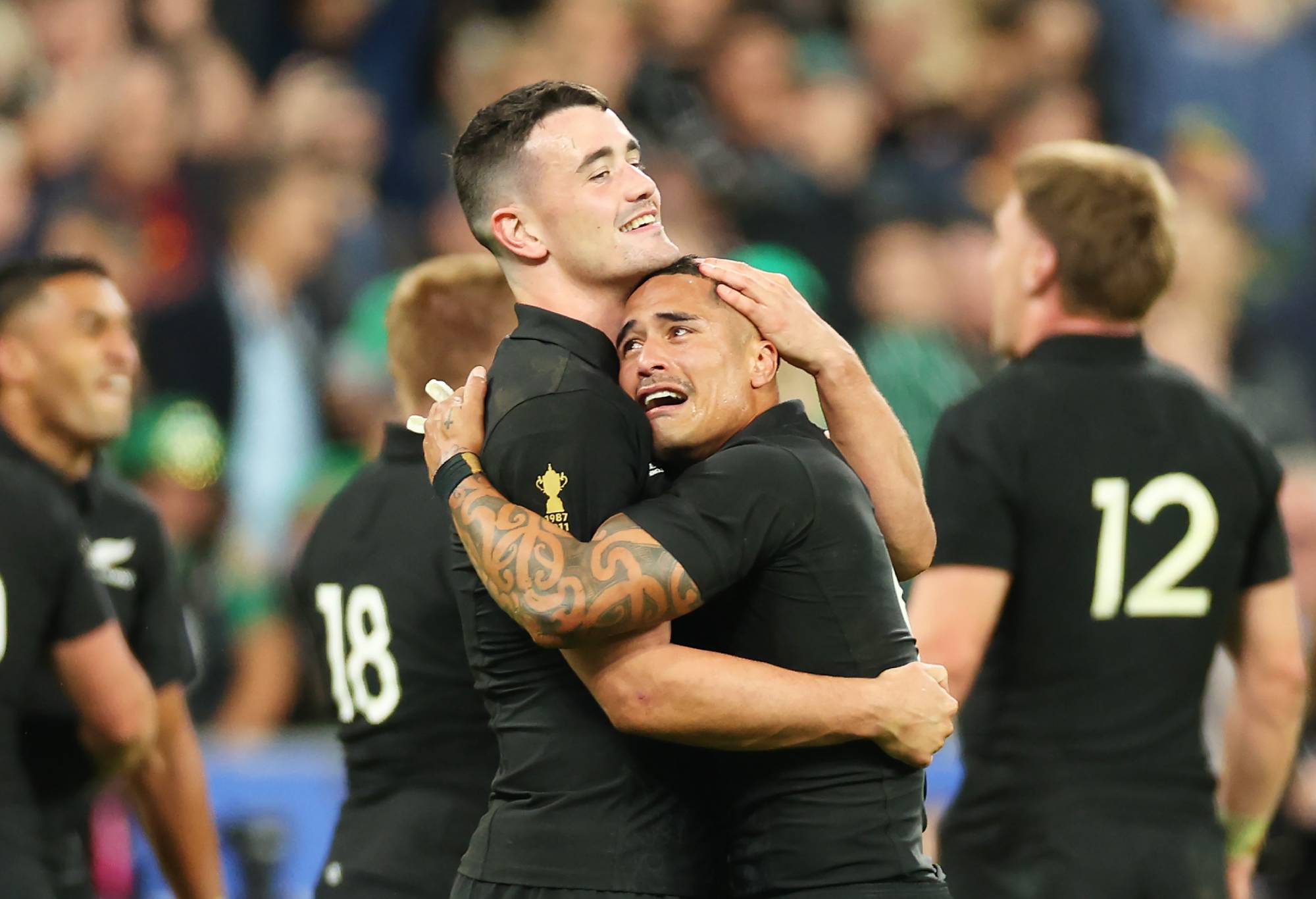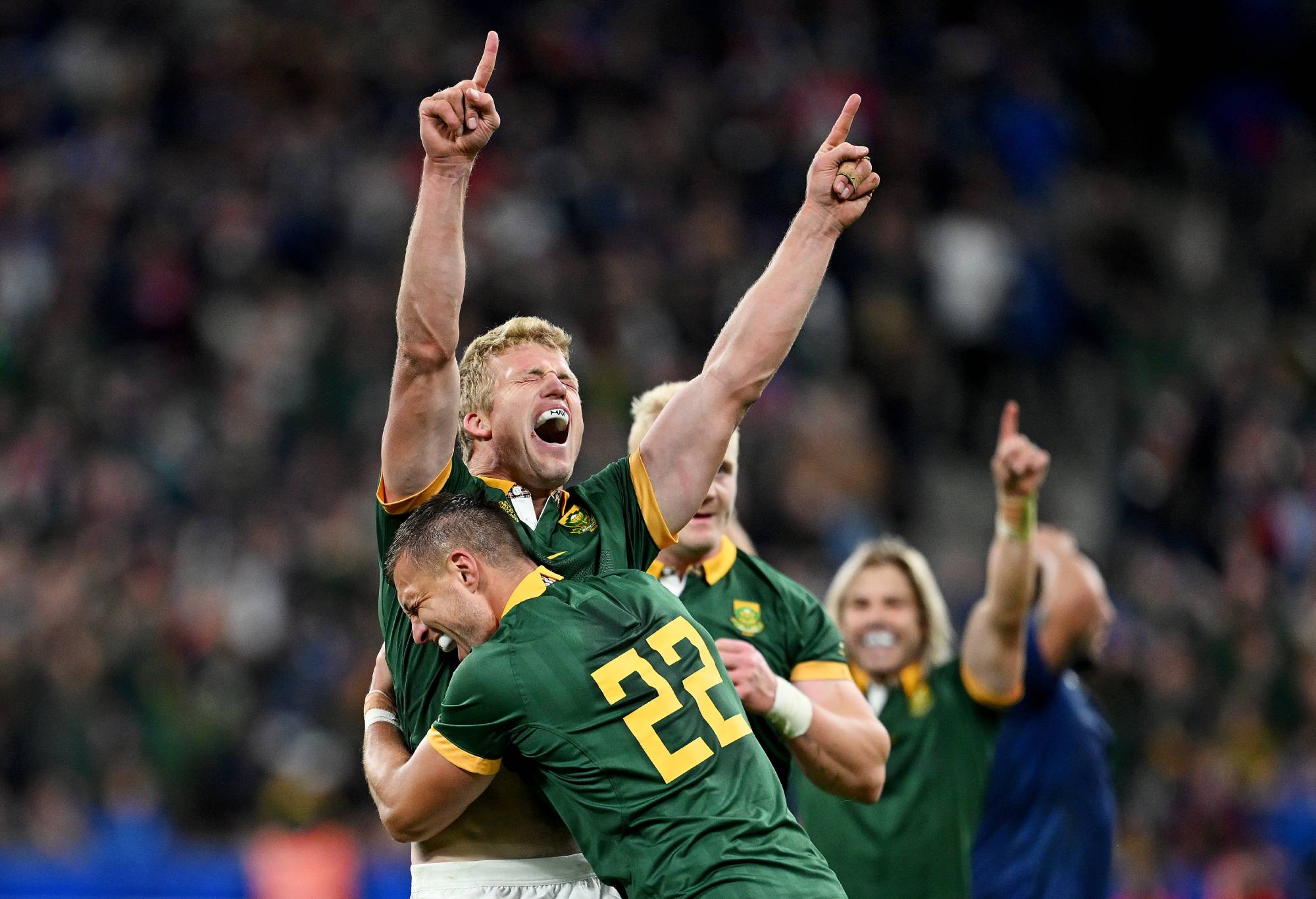While Australian rugby was busy trying to work out how to convince states to centralise themselves, the Rugby World Cup got on with the job of delivering four intriguing, perhaps surprising, but absolutely brilliant quarter-finals in Marseille and Paris.
Argentina and New Zealand, and England and South Africa, will now face off next weekend for a place in the final, and though they’re not the four teams I thought would get there, they’re all very deserving and definitely capable of winning though to the 48th and final match of the tournament.
Watching on at ungodly hours of Sunday and Monday morning, what became clear was that all eight teams entering the quarters have got there knowing their identity and the way the wanted to play their games, and spent the week leading in fine-tuning their methods so that their execution would be right on the night.
Argentina have built nicely into RWC2023 after a rocky start, and again find themselves one win away from a Final. They’ve got there by going back to their set piece and breakdown strengths, and even did the job on Wales without their inspirational leader, Pablo Matera.
New Zealand similarly played to their strengths from the outset, got out to a handy lead early and then rolled up the sleeves as they prepared themselves for whatever Ireland could throw back at them in return. And it was plenty, as we saw.
Oh, for what might have been had the ball not bounced over Dan Sheehan’s head from a cross-kick. And what might have been if Rohan Kelleher had been able to push the ball through Jordie Barrett’s legs and find grass. Of if Caelen Doris hadn’t had had a sneaky little look as he shaped to catch the resulting line drop-out.
Sam Whitelock’s hands on the ball in the 83rd minute and after 37 phases got all the headlines on Sunday, but Ireland knew immediately there were bigger moments before than one play. And now they’ve got a lengthening RWC curse and the perennial ‘four more years’ to stew over the fact.
But in truth, from 13-0 down just 20 minutes in, Ireland had themselves shown incredible patience to get back into the game. They’d earlier withstood the All Blacks mounting well over 30 phases themselves for no return, to get back to within one by the break. When New Zealand kicked away again, Ireland’s maul kicked into gear and earned a penalty try and another ten minutes of an All Black occupying the naughty chair.
They played every bit like the No.1 team in the world, they just happened to find an opposition playing a shade better on the day. It won’t lessen the pain for Ireland fans, but that’s knockout rugby and they might still be the team most adaptable to whatever the rugby gods want to concoct in a knockout scenario.

Will Jordan and Aaron Smith of New Zealand celebrate following the team’s victory during the Rugby World Cup France 2023 Quarter Final match between Ireland and New Zealand at Stade de France on October 14, 2023 in Paris, France. (Photo by Chris Hyde/Getty Images)
England trusted their set piece platform, a breakdown clinic led by three excellent backrowers, and a No.10 and captain who knows his job is to accumulate points and argue with referees about penalties his team had already won. But they also very nearly bottled it, and I still can’t work out why.
They won a scrum penalty in the 62nd minute leading 24-15 and eight minutes later the scores were level.
What ever was in their in-goal electrolytes after two converted tries in those eight minutes, it seemed to work. In no time they back down the other end, with Farrell potting a drop goal that 15 Fijians definitely didn’t see.
The Flying Fijians themselves will reflect on a tournament that began with performances that spoke of a very new Fijian approach to international rugby, but then threatened to revert to stereotype: 15 blokes playing Sevens.
It definitely spoke of their new belief and confidence that they managed to get themselves back on a level footing with England, even if ultimately they didn’t quite have the experience or know-how to finish the job.
Which brings us to France vs South Africa.
Les Bleus stormed out of the blocks in a way that didn’t surprise me at all, just as the Springboks hit back with exactly the response I expected of them.
The Boks bashed up though the middle and found ways of bringing their speed men into the action. The French didn’t kick as much as I thought they might as South Africa came back at them, and in fact dominated territory and possession for the 80 minutes. But they certainly played direct and up through the middle, with some excellent carrying and an offload game to die for.

Pieter-Steph Du Toit and Handre Pollard of South Africa celebrate victory at full-time following the Rugby World Cup France 2023 Quarter Final match between France and South Africa at Stade de France on October 15, 2023 in Paris, France. (Photo by Hannah Peters/Getty Images)
The result? Six tries by halftime and a speed of contest that left players and supporters scrambling for breath, and me scrambling for breakfast, with a podcast, a day job and a busy morning stacking up in front of me.
The Boks started emptying their bench, and the French edged further ahead, before bench freshness started taking hold, and South Africa the lead. And momentum and experience in those crucial, late knockout game moments tend to outlast whatever the challenges want to throw at them.
South Africa knew what was needed in those moments, because they’d played those moments – together – in this quadrennial World Cup cycle. France had a very good game plan and an excellent team, but not enough crucial stress-testing of those crucial moments.
The challenge, for whoever is coaching the Wallabies, and the Rugby Australia powerbrokers, in 2024 is going to be how they can become ready for those moments, and where they get that experience. (Hint: it’s where you left it in August.)
After that, properly defining what the actual hell the mythical Australian Way is when it comes to rugby becomes just as crucial.
It’s been mentioned by the last couple of coaches, and several times this year alone by the current coach. Yet in 2023 at least, there’s been that many different approaches and game plans utilised that I don’t know whether we’ve still not seen the Australian Way of playing, or whether we have seen it and discarded it already.
And then how does the game at the professional level need to be structured? It’s all fine to speak in broad terms of centralisation, but RA’s own statement back in August included a specific quote from CEO Phil Waugh, who said: “The implementation of this model cannot be a one-size-fits-all model, and needs to reflect the specifics of each Super Rugby Club, Member Union and their markets.”
It shouldn’t, therefore, be any surprise at all that the states have arrived at different positions, and nor should that be used as a pressure point in negotiations. RA asking the Brumbies to show their ongoing solvency amidst heavily reduced annual grants and RA themselves taking on more debt against future earnings to keep the lights on is a curious look, to say the least.
But if all the states are actually united on the centralisation of playing and coaching contracts, and a national alignment of S&C and training programs, but not on the subject of corporate governance and operational methods, then that shouldn’t matter. Get on with centralising the rugby elements that can be centralised – which was the whole point of implementing this process from the start.
If this is closer to the New Zealand method than the Irish model, then that frankly doesn’t matter. The solution needs to be best model to suit Australian rugby anyway, not a copy-and-paste from another country.
All eight teams in action this weekend got to the knockout stage by playing their own game and to their own strengths. There’s overlaps of certain elements within these approaches, but all eight countries play the way that suits them best.
Australia would do well to remember that. Find a method that suits our players and our playing strengths and get to work on making that the best it can be. If that’s more evasion and less collision, then fine. If it’s simplifying attack and especially defence, then for goodness sake please do that.
Do something because it suits Australian players and Australian teams, not because X number of tries are scored by all teams in all international rugby if Y and Z occurs. By all means, let the data guide game planning, but it can’t dictate it.
Be innovative. Be patient. Be methodical. Be structured when it suits. But above all else, be Australian.






























































































